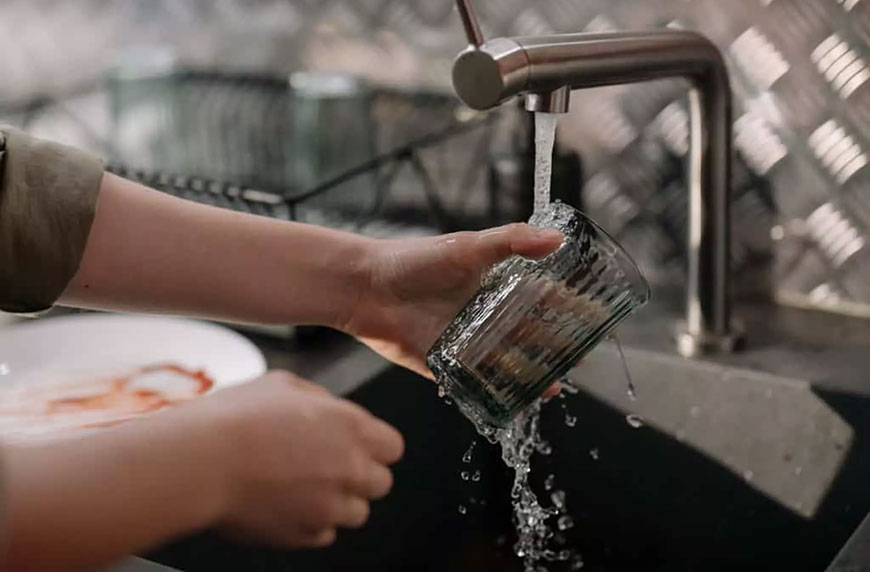Dishwasher vs Hand Washing: Which Is Better for the Planet?
In the dishwasher vs hand washing battle, which is better for the planet? Here's the most eco-friendly way to do your dishes.

Published
In the dishwasher vs hand washing debate, washing dishes by hand seems like it would use less water and be better for the environment. In reality, that's surprisingly not the case.
Aside from the dishwasher being more convenient (and basically doing the work for you!), experts say it's also much more energy- and water-efficient than traditional hand washing techniques. A lot more efficient, in fact.
Dishwasher vs Hand Washing: Which Is Better?

According to Jonah Schein, the national program manager for Homes & Buildings at the U.S. Environmental Protection Agency’s WaterSense Program, you're probably never going to be able to outperform your dishwasher when it comes to saving water.
"A dishwasher—especially a high-performing water-efficient, energy-efficient dishwasher—is going to be the way to go for most people," he told Brightly in an episode of Good Together. "It's really hard to beat the efficiency of a dishwasher. A modern dishwasher uses somewhere between a gallon and a half to five gallons per cycle."
To put its extreme efficiency into perspective, Schein says in order to wash the same amount of dishes as a fully-loaded dishwasher and use less water, you would somehow have to wash eight place settings—the amount a dishwasher can hold—in under two minutes. That's because washing dishes by hand sends more than two gallons of water down the drain per minute.
You may still be thinking... "I'm pretty fast, I could do it!" Well, probably not after realizing what eight place settings worth of dishes actually look like.
"I'm not sure people know what eight place settings mean. But here it is—ready for it?" Schein says. "Eight cups, eight saucers, eight dinner plates, eight bread and butter plates, eight fruit bowls, eight straight-side iced tea glasses, eight dinner forks, eight salad forks, eight knives, 16 teaspoons, one platter, two serving bowls, two serving spoons, and one serving fork"
Unless you've somehow become a superhero overnight, even self-proclaimed dishwashing pros can't wash all of that in under two minutes.
If Using a Dishwasher Isn't an Option

Let's say it takes you 10 minutes to do the dishes. If you leave the water running the entire time (as many people do), those two gallons of water that go down the drain per minute add up to 20 gallons by the time you're done. Luckily, there are still more sustainable ways to wash your dishes by hand.
To minimize water usage when washing dishes by hand, fill half of a split sink with hot water and a small amount of eco-friendly dish soap. Then, fill the other side with clean hot water. (If you don't have a split sink, simply use a big bowl.) Scrape any leftover food waste into your compost bin.
Scrub your dishes on the soapy side of the sink, then transfer them to the clean side for a rinse. Then quickly dry them with dish towels, or let them air-dry on a rack. By using this method, you’re likely using the same amount of water as a typical Energy Star dishwasher.
Are you still looking for ways to help lessen the environmental impacts of your dishwashing habits? Here are some other quick ways to minimize energy and water usage.
3 Ways to Minimize Energy and Water Usage

1. Don’t Pre-Wash Your Dishes
Think about how many gallons of water it takes to rinse off leftover food. Instead, scrape it into a compost bin, and leave the cleaning to the dishwasher.
"That's what the dishwasher is for. Scrape them clean, get the junk off of there," Schein says. "You can't expect the dishwasher to do everything, but you don't want to use as much water as you would have used to hand wash them, and then put them through."
2. Aim for Full Dishwasher Loads
It's tempting to run the dishwasher every night, even when there are only a handful of dishes in it. To save energy, water, and money, stick to full loads.
According to Schein, no matter the number of dishes in the load, the dishwasher is going to use the same amount of water per cycle to clean them. Because of that, "you don't want to eat into your savings by running half-empty dishwasher loads," he says.
3. Install Certified Appliances
When buying a new dishwasher, always look for the WaterSense label. "Every product that bears the WaterSense label is third-party certified for efficiency and performance," Schein says. In the long run, doing so will be beneficial for both the planet and your bank account.

This Vegan Feta Recipe Is the Perfect Eco Cheese Swap
Swap your feta cheese crumbles for this vegan feta recipe to help the planet. All you need is tofu, a jar, and a few other ingredients.

3 Apartment Composting Solutions That Work in Small Spaces
Composting in small spaces is totally possible. Here are some of the best apartment composting solutions to try, from worm bins to Bokashi.

10 Up-and-Coming Sustainable Clothing Materials to Know About
There are so many new sustainable clothing materials on the market, from mushroom leather to Piñatex. Here's what to know about each.

